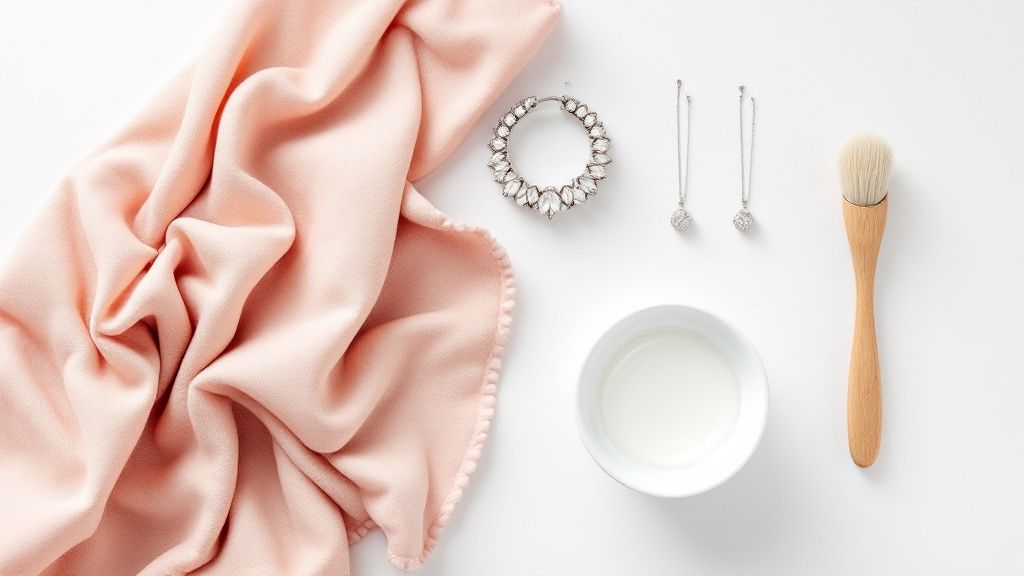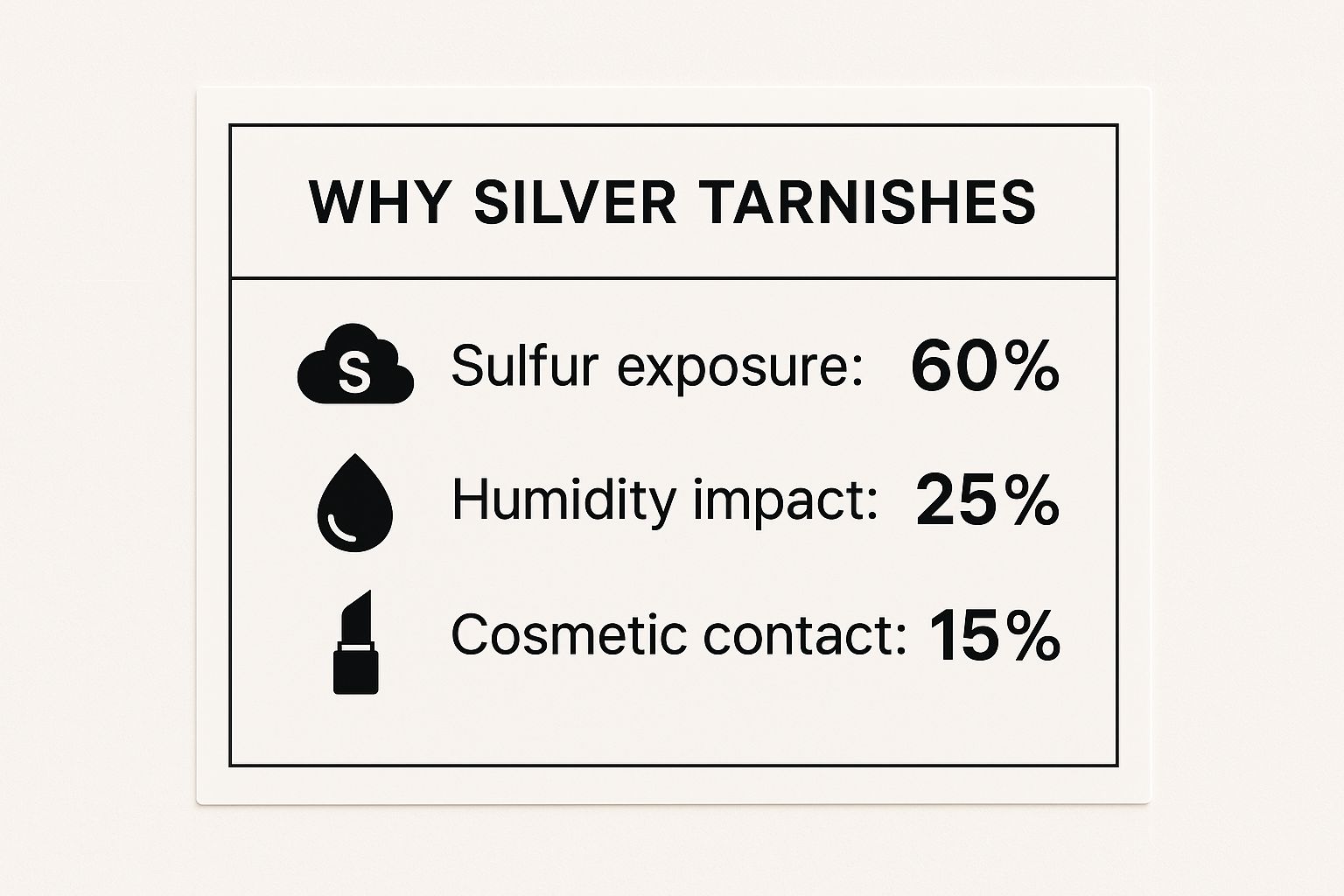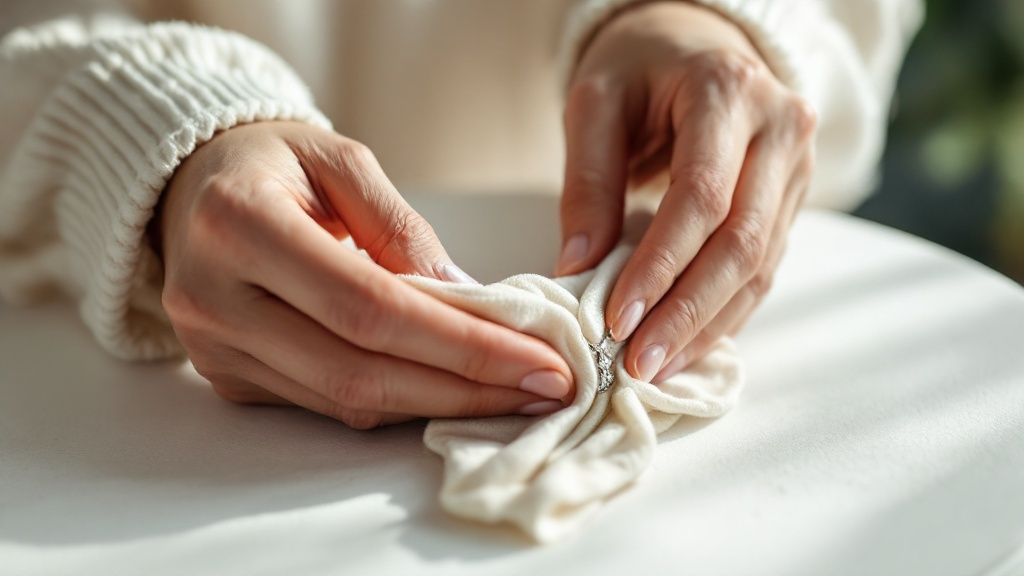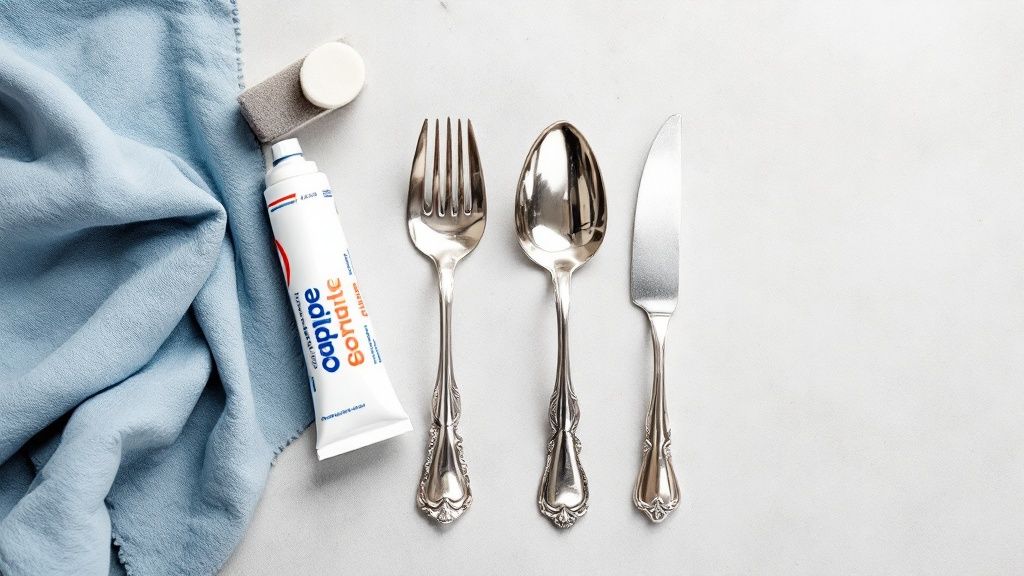Tips to Clean Silver Jewelry at Home | Restore Its Shine
- seanmawhinney
- May 4
- 13 min read
The Science Behind Silver Tarnish (And Why It Matters)

That familiar darkening on your silver jewelry, known as tarnish, isn't a sign of poor quality. It's simply a natural chemical reaction. Silver reacts with sulfur-containing compounds present in the air, such as hydrogen sulfide, to form silver sulfide. This silver sulfide is what creates that dull, grayish-black film on the surface.
This means that even the highest quality silver can tarnish.
Understanding the Chemical Reaction
Think of a freshly cut apple turning brown. Just as oxygen interacts with the apple's surface, sulfur compounds interact with silver. The resulting tarnish is a surface layer. This means the silver underneath remains untarnished.
This understanding is crucial for effective cleaning. You're not removing silver itself, just the silver sulfide layer.
Factors Affecting Tarnish
Several factors influence how quickly silver tarnishes. Humidity accelerates the process, as moisture carries sulfur compounds more effectively. Exposure to cosmetics, perfumes, and even certain foods can also hasten tarnishing. These items often contain sulfur or compounds that react with silver.
Even the air quality in your area plays a role. Industrial areas with higher sulfur pollution will naturally lead to faster tarnishing.
Interestingly, the silver jewelry market is booming, demonstrating the enduring appeal of this precious metal. The global market is projected to grow at a CAGR of 4.7% from 2025 to 2034, reaching an estimated value of USD 61.1 billion. This growth reflects the increasing demand for affordable luxury and the influence of global fashion trends. Find more detailed statistics here
The Importance of Proper Care
Understanding the science behind tarnish empowers you to protect your silver jewelry. Proper storage, mindful wearing habits, and gentle cleaning techniques can significantly slow down the tarnishing process.
By understanding the chemistry involved, you can choose the best cleaning methods and preventative measures. This knowledge helps ensure your silver pieces remain radiant for years to come.
Your Silver Cleaning Arsenal: Tools That Actually Work

Keeping your silver jewelry gleaming doesn't have to be a chore. With the proper tools and techniques, you can clean your silver effectively and safely. This section explores the essential supplies for your silver cleaning kit, helping you discern effective methods from marketing hype. Understanding the factors that influence your jewelry's appearance, like even something as seemingly unrelated as website speed, which can affect online shopping experiences, can also improve your cleaning process. The summary box below highlights key cleaning supplies and their uses.
This infographic summarizes the best tools and practices for cleaning silver.
Essential Cleaning Supplies
Often, a few common household items are sufficient for basic silver jewelry cleaning. Mild dish soap and warm water can easily remove daily grime and fingerprints. A soft-bristled toothbrush is excellent for gently cleaning those hard-to-reach crevices. Microfiber cloths are perfect for drying and polishing your silver without causing scratches.
Beyond these basics, consider a silver polishing cloth. These specially treated cloths remove tarnish and restore shine, making them particularly handy for quick touch-ups and maintaining the luster of frequently worn pieces.
For more stubborn tarnish, a silver cleaning solution specifically formulated for jewelry can be very effective.
Choosing the Right Tools
Different types of tarnish and silver alloys may require tailored cleaning methods. Lightly tarnished sterling silver might only need a simple wash with warm water and dish soap. However, heavily tarnished items or those with intricate designs may benefit from a specialized silver cleaning solution or paste.
One popular and effective natural cleaning method is a baking soda paste. Simply mix baking soda with water to form a paste, apply it to the tarnished silver, and gently scrub with a soft brush.
Understanding Product Safety
Not all silver cleaning products are the same, and some can actually harm your jewelry. Avoid harsh chemicals like bleach and ammonia, as these can etch the silver. Abrasive cleaners can also scratch the surface, diminishing its shine.
When selecting a commercial silver cleaner, choose one specifically designed for jewelry. Always test a new cleaning product on a small, hidden area of your jewelry first to check for any adverse reactions.
To help you choose the best cleaning supplies for your silver, we've compiled the following comparison:
Silver Cleaning Supplies Comparison Comparison of different supplies for cleaning silver jewelry, including effectiveness, safety considerations, and best uses
Cleaning Supply | Effectiveness | Safety Considerations | Best For | Not Recommended For |
|---|---|---|---|---|
Mild Dish Soap & Warm Water | Effective for regular cleaning and light tarnish | Very safe for most silver | Routine cleaning, removing fingerprints and light grime | Heavily tarnished silver |
Soft-Bristled Toothbrush | Helps clean hard-to-reach areas | Safe when used gently | Intricate designs, crevices | Antique or delicate silver |
Microfiber Cloth | Safe for drying and polishing | Very safe | Drying, polishing, final buffing | Initial cleaning of tarnished silver |
Silver Polishing Cloth | Removes tarnish and restores shine | Generally safe, but follow product instructions | Quick touch-ups, maintaining shine | Heavily tarnished or oxidized silver |
Silver Cleaning Solution | Effective for heavier tarnish | Choose jewelry-specific solutions, test in an inconspicuous area first | Stubborn tarnish, oxidized silver | Untested silver, antique or delicate pieces |
Baking Soda Paste | Natural and effective for moderate tarnish | Generally safe, use gently | A good alternative to commercial cleaners | Very delicate silver |
This table provides a quick overview of various silver cleaning supplies and their best uses. Remember to always prioritize safety and test any new cleaning method on a small, inconspicuous area first.
Quick Reference: Key Takeaways for Cleaning Silver
Here’s a summary of essential tools and best practices for cleaning silver jewelry:
Mild Dish Soap & Warm Water: Effective for regular cleaning and light tarnish.
Soft-Bristled Toothbrush: Gently cleans intricate details.
Microfiber Cloth: Safe for drying and polishing.
Silver Polishing Cloth: Removes tarnish and restores shine.
Silver Cleaning Solution: For heavier tarnish.
Baking Soda Paste: A natural and effective cleaning option.
Avoid: Harsh chemicals and abrasive cleaners.
These tools and tips will help you keep your silver sparkling. However, professional cleaning is sometimes necessary, especially for delicate or antique items.
Daily Maintenance: Keeping Silver Beautiful With Minimal Effort

The secret to radiant silver jewelry isn't about complex cleaning routines. It's about consistent, gentle care. Much like a quick wipe keeps kitchen counters sparkling, regular attention preserves your silver's shine. Incorporate simple practices into your daily routine to maintain its natural brilliance.
Simple Steps for Daily Silver Care
One of the easiest ways to keep your silver jewelry looking its best is by wiping it down after each wear. Use a soft, lint-free cloth, such as a microfiber cloth. This removes fingerprints, oils, and everyday grime, preventing buildup that can lead to tarnish. Think of it like wiping a steamed-up mirror—a quick swipe prevents lasting marks. For more cleaning tips and techniques applicable to other surfaces, consider resources like those for cleaning a mirror.
Be mindful of what your silver touches. Avoid wearing it while swimming, cleaning, or applying lotions and perfumes. These substances can accelerate tarnishing and damage delicate surfaces. This proactive approach minimizes the need for frequent deep cleanings.
Knowing When Simple Cleaning Is Enough
A quick wipe with a soft cloth is often all your silver jewelry needs. However, if you notice dullness, a gentle wash with mild dish soap and warm water can be effective. Use a soft-bristled toothbrush to clean intricate details or hard-to-reach areas. Treat your silver like delicate dishes—gentle motions and mild soap prevent damage.
Building a Routine for Long-Term Brilliance
The key to effortless silver care is consistency. Just like brushing your teeth, incorporate a quick silver check into your routine. This could be a visual inspection or a quick wipe-down. This habit helps you catch and address tarnish early before it becomes a problem. It also makes you more aware of your jewelry's specific needs.
The global jewelry market is experiencing growth, with silver jewelry playing a significant role. The market is projected to grow from $219.27 billion in 2024 to $234.8 billion in 2025, a CAGR of 7.1%. This growth is fueled by cultural influences, economic factors, and effective marketing. Silver jewelry, in particular, benefits from affordability and style. To learn more about these market dynamics, explore available resources. This consistent demand underscores the importance of proper care, ensuring your pieces remain beautiful for years to come.
Tackling Tough Tarnish: Transformation Techniques That Work
When tarnish on your silver jewelry becomes more than a light film, simply wiping it down won't be enough. For heavier tarnish, you'll need more effective cleaning methods. However, it's crucial to proceed with caution, as harsh techniques can damage delicate silver pieces.
The Aluminum Foil Method: Ion Exchange in Action
One highly effective method for cleaning significantly tarnished silver involves a chemical process called ion exchange. This method uses aluminum foil, baking soda, and hot water. Line a bowl with the aluminum foil, place your tarnished silver items inside, sprinkle them with baking soda, and then pour hot water over the pieces. You'll see the tarnish transfer from the silver to the aluminum foil, leaving your jewelry clean and bright.
This reaction occurs because aluminum is more reactive than silver. The sulfur ions in the tarnish are drawn to the aluminum, effectively reversing the tarnishing process. It's a simple yet powerful method for restoring your silver's shine.
The Baking Soda Paste Approach: Gentle Yet Effective
For a less intensive cleaning method, create a paste using baking soda and water. Apply this paste to the tarnished silver with a soft-bristled toothbrush or your fingers. Gently rub the paste onto the tarnished areas using small, circular motions. Rinse the silver thoroughly with warm water and dry it with a microfiber cloth.
Baking soda acts as a mild abrasive, helping to lift the tarnish without scratching the silver. This method is particularly well-suited for cleaning intricate designs or pieces with delicate details.
Commercial Silver Dips: A Quick Fix With Cautions
Commercial silver dips provide a fast solution for tarnish removal. However, these dips often contain strong chemicals. While these chemicals are effective, they can sometimes damage certain types of silver, particularly antique or delicate items. Always test the silver dip on a small, hidden area of the piece before submerging the entire item. It's also important to avoid using silver dips on jewelry containing gemstones, as the chemicals can damage porous or sensitive stones.
When using a silver dip, carefully follow the manufacturer's instructions. Thoroughly rinse the jewelry after dipping to ensure all chemical residue is removed.
Assessing Tarnish and Adapting Techniques
The best cleaning method depends on the severity of the tarnish and the type of silver. A simple baking soda paste might be sufficient for light tarnish. However, for heavy tarnish, the aluminum foil method or a commercial silver dip (used with caution) might be required.
The silver jewelry market is heavily influenced by silver production and supply. The global silver supply is forecast to reach an 11-year high of 1.05 billion ounces in 2025, with increased mine production. However, demand is expected to fluctuate across different regions. You can learn more about this topic. These market trends underscore the enduring value of silver, making proper care and cleaning essential for protecting your silver jewelry.
Remember to always test any cleaning method on a small, inconspicuous area first. By understanding these techniques and applying the most appropriate one, you can keep your cherished silver jewelry looking its best for years to come.
Protecting Gemstones: Specialized Cleaning for Combined Pieces

Silver jewelry often features beautiful gemstones, adding splashes of color and brilliant sparkle. However, cleaning these combined pieces requires a more thoughtful approach. While certain cleaning methods are excellent for silver, they can be detrimental to some gems. Therefore, a universal cleaning strategy isn't suitable for silver jewelry adorned with gemstones.
Understanding Gemstone Sensitivity
Each gemstone possesses unique properties and vulnerabilities. Some, like turquoise and pearls, are porous and easily damaged by harsh chemicals or even water. Others, such as opals, contain water within their structure, making them sensitive to temperature fluctuations and prolonged soaking. Even durable stones like cubic zirconia require specific care. Understanding these individual needs is paramount for proper cleaning.
Think of it this way: imagine cleaning a delicate sponge (a porous gemstone) with a scouring pad (harsh chemicals). The sponge would undoubtedly be damaged. Porous gemstones react similarly to inappropriate cleaning methods.
Tailored Cleaning for Common Combinations
This section offers tailored cleaning instructions for some of the most popular silver and gemstone pairings. Sourced from expert jewelers and gemologists, this advice will help maintain the beauty and integrity of your gemstone jewelry.
Silver with Turquoise: Use only a slightly damp, soft cloth for cleaning. Never immerse turquoise in water or cleaning solutions.
Silver with Opals: A soft, dry cloth is best. Avoid ultrasonic cleaners and extreme temperatures.
Silver with Pearls: After each wear, gently wipe pearls with a damp cloth to remove body oils and perfumes. Avoid soaking or harsh chemicals.
Silver with Cubic Zirconia: While generally more durable, avoid harsh chemicals and extended soaking. Mild dish soap and warm water are typically safe.
Gemstone Sensitivity Guide
To simplify gemstone care, the following table summarizes common sensitivities and recommended cleaning practices. This quick reference guide will help you choose the appropriate cleaning method for your specific gemstones.
Gemstone Type | Water-Safe | Soap-Safe | Silver Polish Safe | Ultrasonic Safe | Special Considerations |
|---|---|---|---|---|---|
Turquoise | No | No | No | No | Extremely porous, clean only with a slightly damp cloth |
Opal | No | No | No | No | Contains water, avoid temperature extremes and soaking |
Pearl | Limited (damp cloth) | No | No | No | Porous, avoid soaking and chemicals |
Cubic Zirconia | Yes | Yes (mild) | No | No | Although durable, avoid harsh chemicals |
Most other gemstones | Limited (damp cloth) | No | No | No | Consult a jeweler for specific care instructions |
This table highlights the importance of understanding individual gemstone properties. While some, like cubic zirconia, tolerate mild soap and water, others, like turquoise, require minimal contact with moisture. Always consult a jeweler for specific instructions if you're unsure about a particular gemstone.
Protecting Your Gemstones During Cleaning
When cleaning silver jewelry with gemstones, concentrate on the silver around the stones. If your gemstones are sensitive to water or cleaning solutions, avoid submerging the entire piece. A soft-bristled brush, like a child's toothbrush, can be used to gently clean around the settings.
Be extremely gentle and avoid putting direct pressure on the stones, which could loosen them from their settings. Also, consider any treatments the gemstones may have undergone. Many stones are treated to enhance their color or clarity, and these treatments can be negatively affected by improper cleaning. For instance, heat treatments, common for many gemstones, can be damaged by excessive heat or chemicals. When in doubt, consult a professional jeweler.
By following these guidelines, you can effectively clean your silver jewelry while protecting the beauty and longevity of your precious gemstones. Proper care and cleaning will preserve your jewelry's value, ensuring it remains a treasured possession for years to come.
Preservation Mastery: Smart Storage Solutions That Prevent Tarnish
Proper storage is essential for maintaining the sparkle of your silver jewelry and minimizing the need for frequent cleaning. Just as proper storage prevents rust on a car, the right storage solutions for silver can dramatically reduce tarnish. This section explores best practices and tools for preserving your silver's brilliance.
The Science Behind Anti-Tarnish Products
Anti-tarnish products work by absorbing the sulfur compounds present in the air that cause tarnish. Imagine them as tiny sponges soaking up humidity in a damp room. These products create a protective barrier around your silver, preventing the chemical reaction that leads to discoloration.
Silica packets, commonly found in shoe boxes and electronics packaging, are excellent examples. These small packets contain silica gel, which effectively absorbs moisture and sulfur, creating a drier environment.
Similarly, anti-tarnish strips contain chemicals that react with and neutralize sulfur before it comes into contact with your silver. These strips are particularly effective in enclosed spaces like jewelry boxes.
Creating an Optimal Storage Environment
The best storage environment for silver jewelry is cool, dry, and dark. Avoid storing silver in humid areas like bathrooms, as moisture accelerates tarnish. Direct sunlight can also cause discoloration over time.
Think of it like preserving fresh flowers; you wouldn't leave them in a hot, sunny location. Silver jewelry, similarly, thrives in a cool, dark environment.
Storage Solutions That Work
Anti-Tarnish Bags: These specially treated bags create a barrier against sulfur and moisture, offering excellent protection for individual pieces.
Jewelry Boxes with Anti-Tarnish Lining: These boxes provide a dedicated space for your collection while incorporating anti-tarnish materials within the lining.
Silica Packets: Placing silica packets in your jewelry box or storage containers helps absorb excess moisture.
Anti-Tarnish Strips: Placed inside a jewelry box, these strips neutralize sulfur compounds, further protecting your silver.
Wearing Habits and Quick Maintenance Checks
Even with the proper storage, certain habits can accelerate tarnishing. For example, wearing silver jewelry while showering or swimming exposes it to chemicals and moisture that can cause discoloration. Perfumes, lotions, and hairspray can also contribute to tarnish.
Regularly inspect your silver jewelry for any early signs of tarnish. Wiping with a soft cloth after each wear removes fingerprints and oils, preventing buildup that can lead to tarnishing. Think of it like a quick car wash – regular cleaning prevents dirt and grime from accumulating. This simple practice can significantly extend the time between deeper cleanings.
By combining effective storage solutions with mindful wearing habits and regular checks, you can preserve the brilliance of your silver jewelry collection with minimal effort, ensuring your pieces remain beautiful for years to come. Much like a museum meticulously preserves its artifacts, creating a protective environment keeps your silver jewelry looking its best.
When To Call The Professionals: Expert Intervention Guide
Knowing how to clean silver jewelry at home is essential. However, sometimes professional help is the best option. For intricate pieces, antique silver, or jewelry with delicate gemstones, professional cleaning ensures safe and effective restoration. This guide helps you recognize when it’s time to seek expert care.
Recognizing The Need For Professional Cleaning
Certain situations call for professional expertise. Antique silver, often passed down through generations, requires specialized care to avoid damage. Intricate designs with filigree or detailed engravings can be difficult to clean thoroughly at home. These delicate details can trap tarnish, making complete removal challenging without professional tools.
Additionally, if your silver jewelry includes fragile gemstones, particularly those sensitive to cleaning solutions or ultrasonic vibrations, professional cleaning minimizes the risk of damage. For example, a vintage silver brooch with intricate details and opal inlays would benefit from professional cleaning.
A professional can safely clean the intricate silverwork and address the specific needs of the opal, which is sensitive to moisture. Choosing professional care ensures the longevity and beauty of such delicate pieces.
Evaluating A Jeweler's Expertise
Not all jewelers possess the same level of expertise in silver cleaning. Before entrusting your valuable pieces, ask specific questions to gauge their knowledge. Inquire about their cleaning methods for different silver types and gemstones.
A knowledgeable jeweler will understand the nuances of various cleaning techniques. They will recommend the most appropriate approach for your specific jewelry. Also, ask about their experience with antique or delicate pieces.
This will help you assess their ability to handle your valuable items with the necessary care. A skilled jeweler will explain the potential risks and benefits of different cleaning methods, allowing you to make informed decisions.
Understanding Professional Cleaning Techniques
Professional jewelers employ advanced cleaning techniques that are often unavailable to consumers. Ultrasonic cleaning uses high-frequency sound waves to remove tarnish and dirt from intricate crevices. This method is highly effective for reaching areas a brush can't access.
However, it's not suitable for all gemstones, highlighting the importance of a jeweler's expertise. Another professional technique is rhodium plating. This process involves applying a thin layer of rhodium, a precious metal from the platinum family, to the silver.
Rhodium plating enhances the silver's brilliance, resistance to tarnish, and durability. This protective layer helps prevent future tarnishing, keeping your silver jewelry looking its best.
Timelines and Costs
Professional silver cleaning typically involves a turnaround time of a few days to a week. This depends on the jeweler's workload and the complexity of the cleaning process. Costs vary based on the piece's intricacy, the type of gemstones involved, and the cleaning methods required.
It's always advisable to obtain a quote upfront to avoid surprises. By understanding when professional cleaning is necessary and how to evaluate a jeweler's expertise, you can ensure your treasured silver jewelry receives the best possible care.
These expert interventions preserve the beauty and longevity of your silver pieces, allowing you to enjoy their sparkle for years to come. Ready to elevate your jewelry collection? Discover exquisite pieces and expert care at Panther De Luxe Shop.
Article created using [Outrank](https://outrank.so)

Comments